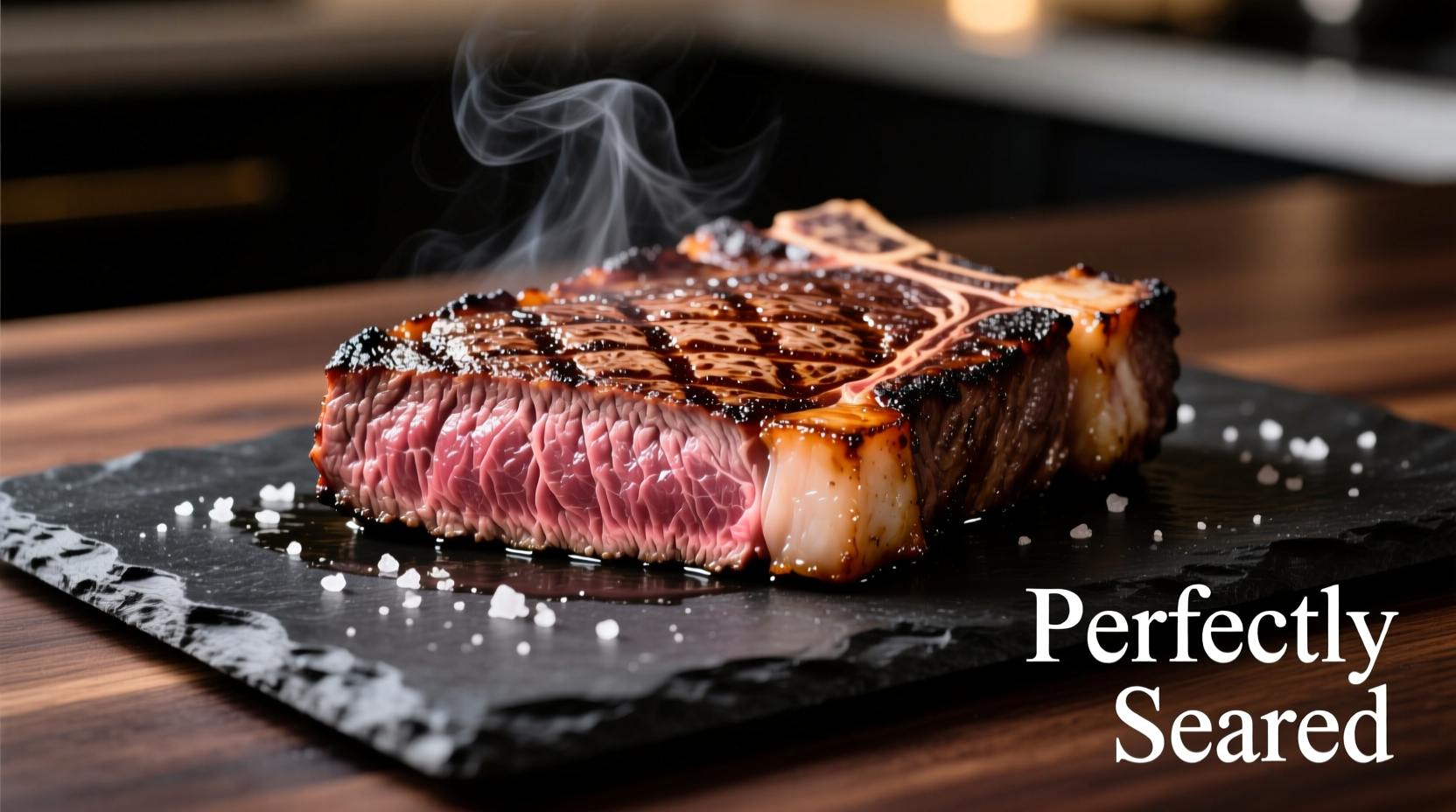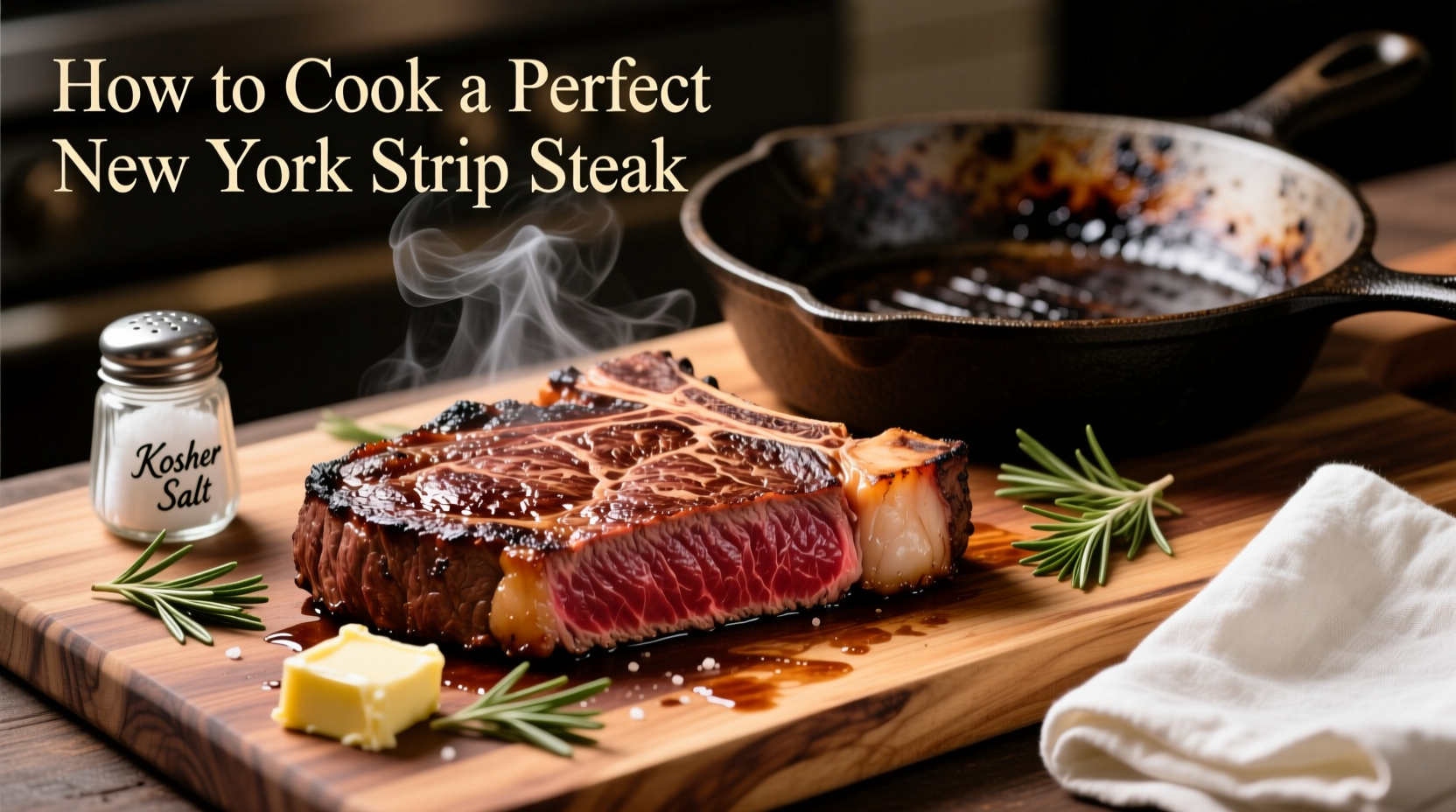For perfectly cooked New York strip steak every time, bring the steak to room temperature for 45-60 minutes, season generously with coarse salt and freshly ground black pepper, then sear in a smoking hot cast iron skillet for 3-4 minutes per side. Finish in a 400°F oven until reaching your desired internal temperature (125°F for rare, 135°F for medium-rare), then rest for 8-10 minutes before slicing. This method delivers a flavorful crust with evenly cooked, juicy interior.
There's nothing quite like a perfectly cooked New York strip steak—tender, juicy, and packed with rich beef flavor. Whether you're cooking for a special occasion or simply craving a restaurant-quality meal at home, mastering this cut is easier than you think. The New York strip, also known as Kansas City strip or top loin steak, comes from the short loin section and offers the ideal balance of tenderness and robust beefiness without excessive marbling.
The Essential Prep Phase: Setting Yourself Up for Success
Before your steak ever touches heat, proper preparation makes all the difference. Start by selecting a quality cut with bright red color and fine marbling—look for USDA Choice or Prime grade for best results. Allow your steak to come to room temperature for 45-60 minutes before cooking; this ensures even cooking throughout. Never skip this step, as cooking a cold steak straight from the refrigerator leads to uneven results with an overcooked exterior and undercooked center.
Seasoning is equally critical. Use coarse kosher salt (about 1 teaspoon per pound) and freshly ground black pepper. Apply salt at least 40 minutes before cooking to allow it to penetrate the surface, creating better flavor and texture. For those wondering how long to cook new york strip steak on cast iron, proper seasoning is your first step toward that perfect crust.
| Steak Thickness | Room Temperature Time | Salt Application Time |
|---|---|---|
| 1 inch | 45 minutes | 40 minutes before cooking |
| 1.5 inches | 60 minutes | 45 minutes before cooking |
| 2 inches | 75 minutes | 60 minutes before cooking |
Cooking Method Options: Finding Your Perfect Technique
When considering the best way to cook new york strip steak medium rare, you have several excellent options. Each method has its advantages depending on your equipment and preferences:
Pan-Searing (Most Reliable Home Method)
This technique delivers consistent results with minimal equipment. Use a heavy cast iron or carbon steel skillet preheated to 500°F for optimal searing. The high heat creates that coveted Maillard reaction—the chemical process that develops complex flavors and the perfect crust.
Grilling (For Outdoor Flavor)
Ideal for summer cooking, use a two-zone fire with direct heat for searing and indirect heat for finishing. This gives you more control over doneness while adding that distinctive smoky flavor.
Reverse Sear (For Thicker Cuts)
Start in a low oven (275°F) until the steak reaches 115°F internally, then finish with a quick sear. This method ensures perfectly even cooking from edge to edge, especially for steaks thicker than 1.5 inches.

The Cooking Process: Step-by-Step Guide
Follow these steps for restaurant-quality results at home:
- Pat the steak completely dry with paper towels—moisture is the enemy of a good sear
- Heat your cast iron skillet over medium-high heat until smoking hot (about 5 minutes)
- Add high smoke-point oil (avocado or grapeseed) just before adding steak
- Place steak in skillet and press gently for full contact
- Sear undisturbed for 3-4 minutes until a deep brown crust forms
- Flip and sear the other side for another 3-4 minutes
- Add butter, garlic, and herbs to the pan during the last 2 minutes, basting continuously
- Check internal temperature with an instant-read thermometer
For perfect temperature for new york strip steak, the USDA Food Safety and Inspection Service recommends minimum internal temperatures of 145°F (followed by a 3-minute rest) for food safety. However, most steak enthusiasts prefer lower temperatures for optimal texture and juiciness:
- Rare: 120-125°F (bright red center)
- Medium-rare: 130-135°F (warm red center) - most recommended
- Medium: 140-145°F (warm pink center)
- Medium-well: 150-155°F (slight pink center)
- Well-done: 160°F+ (little to no pink)
Remember that the steak's temperature will continue to rise 5-10°F during resting—a phenomenon known as carryover cooking. Always remove your steak from heat 5°F below your target temperature.
The Critical Resting Phase: Why Patience Pays Off
Resting your steak isn't optional—it's essential. When you cut into a steak immediately after cooking, the juices rush out, leaving you with a dry piece of meat. During resting, the muscle fibers relax and reabsorb those precious juices. For a standard 1-1.5 inch New York strip, rest for 8-10 minutes loosely tented with foil.
According to food science research from the Culinary Institute of America, resting allows for more even temperature distribution and prevents excessive juice loss when slicing. This is particularly important when cooking how to sear new york strip steak properly, as the intense heat creates significant internal pressure that needs time to stabilize.
Serving and Enjoying Your Perfect Steak
When ready to serve, slice against the grain at a 45-degree angle using a sharp knife. Cutting against the grain shortens the muscle fibers, making each bite more tender. For New York strip, look for the direction of the fibers and slice perpendicular to them.
Pair your steak with simple sides that complement rather than compete with its rich flavor:
- Garlic mashed potatoes
- Roasted asparagus
- Creamed spinach
- Simple arugula salad with lemon vinaigrette
For sauces, keep it classic with a pat of compound butter, a drizzle of high-quality olive oil, or a simple pan sauce made from the flavorful drippings in your skillet.
Troubleshooting Common Steak Problems
Problem: Steak is overcooked
Solution: If caught early (still above 120°F), place in an ice bath for 30-60 seconds, then return to low heat while monitoring temperature closely. For future attempts, use an instant-read thermometer and remove steak 5°F below target temperature.
Problem: Lack of crust formation
Solution: Ensure your pan is properly preheated (water should sizzle and evaporate immediately), pat steak completely dry, and avoid moving the steak during initial searing. For how to sear new york strip steak properly, proper pan temperature is non-negotiable.
Problem: Uneven cooking
Solution: Make sure steak is at room temperature before cooking, and consider the reverse sear method for thicker cuts. Pressing gently during initial sear ensures full contact with the cooking surface.
Problem: Steak sticks to the pan
Solution: Be patient—steak will naturally release when a proper crust has formed. Forcing it off too early causes tearing. Ensure adequate preheating and use sufficient high smoke-point oil.
Advanced Tips for Steak Perfection
Temperature Control is Key
Invest in a reliable instant-read thermometer—the Thermapen or similar. Guessing doneness leads to inconsistent results. For those exploring perfect temperature for new york strip steak, precise temperature monitoring transforms your cooking.
Butter Basting Technique
During the final 2 minutes of cooking, add 2 tablespoons of butter, 2 crushed garlic cloves, and fresh herbs (rosemary or thyme) to the pan. Tilt the pan and spoon the melted butter continuously over the steak for added flavor and richness.
Avoiding Common Mistakes
Never pierce your steak with a fork while cooking—this releases precious juices. Use tongs instead. Also, resist the urge to press down on the steak excessively, as this squeezes out moisture and can cause flare-ups.
When considering how long to cook new york strip steak on cast iron, remember that thickness matters more than time. A 1-inch steak might need 8-10 minutes total cooking time, while a 1.5-inch steak could require 12-14 minutes. Always rely on internal temperature rather than timing alone.
Storage and Reheating Tips
If you have leftovers (which is rare with a perfectly cooked steak!), store in an airtight container in the refrigerator for up to 3 days. For best reheating results:
- Slice cold steak before reheating
- Use low heat in a skillet with a bit of butter
- Heat just until warmed through (don't overcook)
- Alternatively, place in a 250°F oven until internal temperature reaches 110°F
For those concerned about food safety, the USDA provides comprehensive guidelines on safe handling of leftovers at https://www.fsis.usda.gov/food-safety/safe-food-handling-and-preparation/food-safety-while-grilling/leftovers.











 浙公网安备
33010002000092号
浙公网安备
33010002000092号 浙B2-20120091-4
浙B2-20120091-4